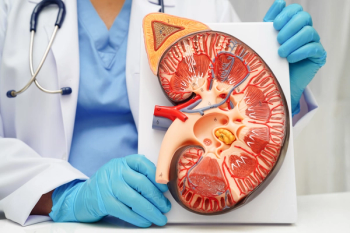
Evaluating Single Agent PARP Inhibitors or Combination Therapies for Maintenance Treatment of Ovarian Cancer
Olaparib and niraparib both show promise in the maintenance treatment of ovarian cancer, though they may each be appropriate for different patient populations.
When debating whether to begin a single agent poly-ADP-ribose polymerase (PARP) inhibitor or a combination therapy in patients who need maintenance treatment for ovarian cancer, clinicians should consider frontline versus recurrent treatments and whether the treatments will impact future therapies, according to a session at the Hematology/Oncology Pharmacy Association 2021 virtual conference.
In 2021, presenter Colleen Bohnenkamp, PharmD, BCOP, BCPS, said there were an estimated 22,410 new diagnoses of ovarian cancer and 13,770 deaths. Epithelial ovarian cancer accounts for approximately 90% of these cases and the disease has a relatively low 5-year survival rate, largely because of subtle symptoms such as bloating, which are very common in postmenopausal women.
Bohnenkamp reviewed the traditional treatment pathway, which begins with neoadjuvant platinum-based chemotherapy for eligible patients, followed by surgical staging and debulking, adjuvant platinum-based chemotherapy, observation or frontline maintenance therapy, and more chemotherapy if a relapse occurs. She noted that an occurrence within 6 months of chemotherapy is considered platinum-resistant and has lower survival rates, whereas an occurrence more than 6 months after chemotherapy is platinum-sensitive.
Traditional frontline maintenance therapy is done with bevacizumab, although Bohnenkamp noted that its use remains controversial because clinical trials have not found a large overall benefit. Updated progression free survival (PFS) data from the ICON-7 and GOG-218 trials showed no difference in PFS and a restricted mean survival time difference of 1.6 months. Bohnenkamp spent the rest of the presentation discussing olaparib and niraparib as potential alternatives to bevacizumab.
Olaparib was the first approved fronline PARP inhibitor, with its approval based on the SOLO-1 trial. Participants in that trial had to have germline or somatic BRCA1/2 mutation and they received either olaparib 300 mg once a day or a placebo. Results were first reported in 2018, with investigators finding a long PFS survival benefit. Notably, the secondary outcome of a second median PFS has not yet been reached. These findings suggest that olaparib does not limit patients’ ability to respond to future therapies, which Bohnenkamp said is an important consideration without an abundance of clinical data yet.
The investigators also found a significantly longer time to subsequent therapy or death in the olaparib arm, with all subgroup analyses favoring olaparib. The study found a consistent safety profile from the SOLO-2 trial, with anemia and neutropenia noted as common adverse events (AEs).
The PRIMA trial investigated niraparib 300 mg daily, with a primary outcome of PFS survival and a key secondary outcome of OS. Bohnenkamp noted that this was a strong study with higher risk patients, including 35% with stage 4 disease. After 13.8 months of median follow-up, the median PFS in overall study population was 13.8 months in the niraparib group compared to 8.2 months in the standard chemotherapy group.
Investigators also performed subgroup analysis on BRCA-positive participants, homologous replication deficiency (HRD)-positive and BRCA-negative participants, and HRD-negative participants. They found that the most significant PFS survival benefit was among those with BRCA mutations. Notably, 70.9% of patients in the niraparib group required dose reduction and 12% discontinued due to AEs.
Finally, Bohnenkamp compared the trials of olaparib and niraparib and for which patient populations they might work best. Olaparib is approved for patients with BRCA1/2 mutations and the SOLO-1 trial consisted of 15% of patients with stage IV disease, 35% who had received neoadjuvant chemotherapy, and a 96.2% dose intensity. It had a median PFS of 56 months.
Alternatively, the PRIMA trial of niraparib included patients regardless of BRCA or HRD status and had 35% with stage IV disease, 67% who had received neoadjuvant chemotherapy, and a 63% dose intensity. It had a 21.9-month median PFS in the HRD subgroup and a 13.8 month median PFS in the overall patient population.
Based on these findings, Bohnenkamp said clinicians should consider whether the treatment is for frontline or recurrent use, the patient’s tumor mutational characteristics, whether they have had previous exposure to bevacizumab, and the AE profile of the drugs. Pharmacists can play an important role by closely monitoring patients, including conducting follow-ups between provider visits.
REFERENCE
Bohnenkamp C. Approaches to Maintenance Treatment for Ovarian Cancer: Single Agent PARP Inhibitor or Combination? Presented at: Hematology/Oncology Pharmacy Association virtual 2021 conference; April 14, 2021. Accessed April 15, 2021.
Newsletter
Stay informed on drug updates, treatment guidelines, and pharmacy practice trends—subscribe to Pharmacy Times for weekly clinical insights.
















































































































































































































